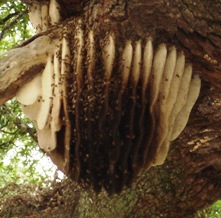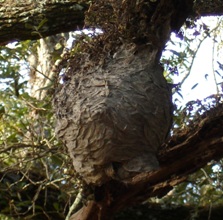Yellow jackets and log homes are a poor mix. So are bees, carpenter ants, and powder post beetles, all of which can cause log home problems. When you purchase your log home, you probably imagined living in tranquility with nature, like spotting deer outside your windows or bird watching from the comfort of your deck or porch. You probably didn’t imagine a nest of yellow jackets in your log home or a beehive hanging off the porch!
Unfortunately, many insects love log homes as much as we do. But fortunately, there are solutions to ants, beetles, honeybees and yellow jackets in log homes.

Many people just call stinging flying insects “bees” but yellow jackets and bees are very different insects.
Yellow jackets are wasps, not bees, though they are often confused with honeybees. Yellow jackets are not picky about where they set up home; they build nests both above and below the ground. Since they are often referred to as bees, they have given honeybees a bad name when it comes to dealing with them.
Keep in mind that yellow jackets can sting more than once when they feel threatened, and their stings are very painful. If you have yellow jackets on your property or if they have set up a nest on your log home, contact a professional to remove the nest safely.
If you have wild honeybees nesting near your log home, they make slightly better neighbors than yellow jackets. They make honey, which is a definite advantage.
These flying insects can only sting once and then they die. The bees know this and are a bit more particular about using their stingers. (A yellow jacket knows it can sting anyone or anything that comes near its nest, and therefore stings without hesitation.)
The honeybee’s nest has an accordion-like appearance. It looks differant from a yellow jacket’s nest; a wasp’s nest appears grey and has a paper-like appearance.


If you think you may have honeybees nesting near your home and you want to remove them, contact a local beekeeper. They may be able to capture the bees and incorporate the hive into an existing apiary.
When insects overstep the bounds of being good neighbors and take up residence in your log home, you have a different problem. We frequently get asked how to get rid of these types of pests. The common thinking is that the insects are causing damage to the logs. Well, that’s not exactly true.
This video will explain what is really going on if you see signs that insects have infested your logs.
There are two types of wood-boring insects that we find in log homes in the Midwest: carpenter ants and powder post beetles. What we have come to know after 40 years of experience is this – these bugs often are indicators that there is rot in the logs. Decaying wood is a food and nesting source for these insects in log homes.
Signs of insects in log homes include holes in the logs, little piles of “sawdust” or the insects themselves. It usually is not enough to just exterminate the bugs, though that may be necessary if there is a large population of them.


If the insects are there because you have rot, what is the solution? We specialize in replacing rotten logs. Most people contact us before the problem is too extensive. Typically, when we inspect a log home or cabin, we find that the rot does not extend into the log mor than a few inches. This makes it possible to replace just the rotten part of the log by cutting out the decayed wood and fitting a half log into the space.

No one wants to have insects building nests nearby. Yellow jackets make lousy neighbors and bees are better off away from your lot. Take action if you see evidence of any damage to your logs to avoid further damage. We are happy to talk to you about any problems you are having on your log home or cabin. Call us at 715 – 373 – 5744 to arrange a personal appointment today.